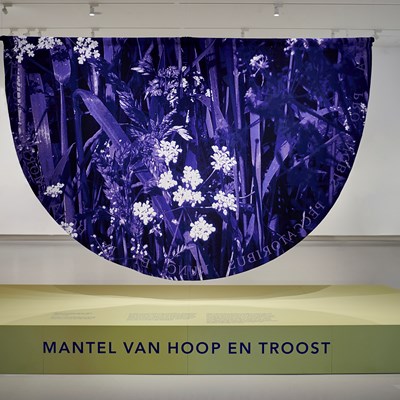Margriet Luyten designed a new cloak for the centuries-old statue of the Virgin Mary in St. John's Cathedral in 's-Hertogenbosch. Mary will wear the cloak during Lent from 2023.
‘The Cloak of Hope and Comfort’ is part of a collection of cloaks for the statue of the Virgin Mary in the cathedral, which are managed by the Brotherhood of Our Lady of Den Bosch. For the new cloak, Luyten was asked to make a link with the pandemic. Consequently, she used her own photos of cow parsley as a starting point for her design: she often saw this delicate flower, also known as Dutch lace, on her walks during the lockdowns. Since the 13th century, Mary’s cloak has often been depicted in art history as a safe place to hide. Luyten references this in the mirrored text at the bottom of the cloak. The text appears the right way round for those who 'symbolically' seek refuge under the cloak.
Luyten edited a photo of cow parsley, turning it a monochrome blue. During weaving, a lot of attention was paid to recreating the photo’s depth in the woven cloth. It was also important to produce a supple drape in a firm and compact fabric. This is because the fabric has to last for years and withstand the annual dressing and undressing of the statue. As a result, satin weaves and a high thread count were used. The fabric is made of a thin cotton yarn in various shades of blue. The white highlights in the image were woven with a shiny viscose yarn. A looser weave was also used for these elements, creating texture in these areas.
The main challenge was weaving the text from the Hail Mary. ‘Ora pro nobis peccatoribus, nunc et in hora mortis nostrae' appears as a mirror image on the inside of the cloak. The text follows the shape of the hem, so it had to be woven in exactly the right place. The pattern used to sew the cloak together was also woven into the fabric. The cloak was woven in two parts, but the text continues seamlessly between the parts.
















Margriet Luyten makes landscape tapestries, using photography and digital weaving techniques combined with hand-embroidered texts. Weaving allows her to capture the sensory experience of a special place in textiles. In addition, she develops series of gum prints and photographic screen prints, and she makes video portraits of artists and art mediators in the last phase of their working lives. Following ‘Life’s work I – the artists’ and ‘Life’s work II – the art mediators’, she is now working on ‘Life’s work III – the art collectors’. Her work is regularly shown in solo exhibitions, including at M HKA Antwerp, Art Rotterdam, Museum De Pont Tilburg, DNB Amsterdam, Verbeke Foundation Belgium and HNBM Den Bosch.

'Extreme care – the first wave through the lens of a doctor', Het Noordbrabants Museum, 's-Hertogenbosch, March-April 2021
The cloak can be seen every year during Lent in St. John's Cathedral in 's-Hertogenbosch